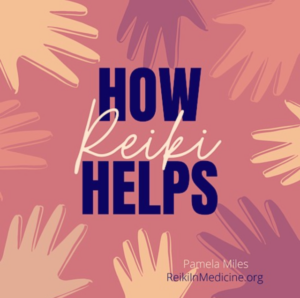 If you’re wondering how Reiki healing helps, think of it this way: when you go to the doctor, she treats your complaint — sore throat, upset stomach, insomnia, whatever symptom or trauma brought you to her medical office.
If you’re wondering how Reiki healing helps, think of it this way: when you go to the doctor, she treats your complaint — sore throat, upset stomach, insomnia, whatever symptom or trauma brought you to her medical office.
When you go to a Reiki practitioner, regardless what brought you there, the Reiki practitioner treats you — the person suffering from the complaint (or the person who doesn’t have any complaints but knows she will if she doesn’t take care of herself).
Ever wonder exactly how Reiki healing helps? Ever ask yourself, just how does Reiki work?
How Reiki healing helps
The fact is, there’s a lot we don’t know about how Reiki practice works. Reiki is, after all, a spiritual practice, like meditation, yoga, or tai chi. Spirituality is a subjective experience, the realm of mystery, so there’s a limit to how much we can objectively know about spirituality. But we do know a few things.
We know spirituality is where people turn to discover purpose and meaning in life, and in life’s experiences. When you wonder why something happened, or look for an anchor amidst strong emotions, you’re reaching into your spirituality. It’s a private treasure trove of support that’s unique to you.
Spiritual practices help you connect with your unseen resources, that innermost core of your being that can’t be measured, but which is vital to your well-being. Perhaps without realizing it, we often gauge a person’s spiritual state, perhaps remarking that a loved one is more spirited today. Doctors recognize that patients with access to their inner resources tend to do better and are easier to treat. That’s especially true of people addressing trauma.
While we know your spirituality is a critically important part of you, we don’t know a lot of specifics about how spiritual practices like Reiki work. But there are a few pieces we do know. Let’s start by looking at the experience of a Reiki treatment.
When you go for a Reiki treatment, the practitioner will likely place hands on the part of your body that hurts (with your permission, of course).
She may or may not start there — each practitioner has her own approach — but she likely won’t stop there. Most Reiki practitioners place hands on a series of hand placements on your head and the front and back of your torso as you lie fully clothed on a treatment table. That’s important because the roots of an imbalance are never where the symptoms present, and the repercussions of trauma ripple throughout the body, affecting how each system functions.
You might notice sensations where the practitioner’s hands are placed. People often do. Heat and subtle movement, maybe flowing or maybe sparky or needly, are common experiences.
Or you might notice that area of your body becomes more open, feels more comfortable. If you had pain, it will likely diminish, and possibly disappear, even if the Reiki practitioner hasn’t yet touched the painful area. You might feel the grip of trauma lessen.
Reiki practice works through balance
How does Reiki practice actually work? How is it possible to experience pain relief in one part of your body when the Reiki practitioner’s hands are somewhere else? That’s because your response to hands-on Reiki practice is both local and global.
No matter where the Reiki practitioner’s hands are, no matter how delightful that light contact may feel, the most important benefit of Reiki healing is what’s happening behind the scenes, inside your own body, where it’s remembering what it knows best — how to heal itself. And the first step in self-healing is to restore balance to the system.
Conventional medicine addresses symptoms and conditions with an oppositional warlike approach, such as the war on cancer. Clearly, there’s a place for that. No one wants a world without hospitals.
Reiki practice works differently. Unlike the oppositional approach of conventional medicine, with interventions that directly oppose problems, Reiki healing does not target symptoms or conditions directly.
The parasympathetic what?
Instead of opposing any complaint head-on, an approach which can be life-saving but which often brings unwanted side effects, Reiki practice is balancing to your whole system. When your body is balanced, your own self-healing mechanisms function at their very best.
While a Reiki hand rests lightly on a particular area of your body, whether or not there is a discernible local response, there is an overall response as your system shifts into parasympathetic nervous system (PNS) dominance.
This is important why?
When the PNS is dominant, the body is in rest-and-digest mode. This means its priority is to recover, to heal, to deeply nourish and restore itself. The body knows well how to do these things, but our busy lifestyle tends to keep us in the reactive sympathetic nervous system (SNS) mode, where the body’s priority is just to get through the day, coping (fight or flight), not healing. That can cause the body to age prematurely, and slow or stymie recovery from injury, illness or surgery.
Our bodies simply cannot cope and heal at the same time. It’s fight/flight or rest/digest — not both at the same time.
Can Reiki healing help YOU?
Now that you know how Reiki healing helps, you can appreciate that Reiki can likely help you, regardless the challenge you’re facing. Read this to learn more.
Here’s a one-page earlier version of this article you can print and share as is with clients and students. The article is copyrighted so please do not change the content or presentation in any way or copy it for other uses. You are welcome to link to the article but do not upload it to your website.
Comment le Reiki peut nous aider is a French translation of this article you can print and share as is, without copying or changing the content or presentation in any way. Voici une traduction de cet article, que vous pouvez imprimer et partager sans copier ou modifier le contenu ou la présentation en aucune façon: Comment le Reiki peut nous aider.
Como ayuda el reiki? is a Spanish translation of this article you can print and share as is, without copying or changing the content or presentation in any way.
Come Aiuta Reiki? is an Italian translation of this article you can print and share as is, without copying or changing the content or presentation in any way.
Como o Reiki pode lhe ajudar? is a Portuguese translation of an earlier version of this article you can print and share as is, without copying or changing the content or presentation in any way.
Como o Reiki pode lhe ajudar? is a Brazilian translation of an earlier version of this article you can print and share as is, without copying or changing the content or presentation in any way.
Hvordan hjælper Reiki healing? is a Danish translation of an earlier version of this article you can print and share as is, without copying or changing the content or presentation in any way.
Related reading:
Yale research shows Reiki helps cardiac patients
Alternative, Conventional, and Traditional Medicine
Reiki speeds recovery from surgery
________________
Looking for more credible information about how Reiki healing helps from a professional with 30+ years of experience? Please join my email list here.
Ready to start practicing Reiki? Read about my small group, live, interactive online Reiki Self Care training.
Are you a Reiki professional? The Reiki Professional Academy will strengthen your skills, and do so where you feel the need for help.

Why not keep things gender neutral instead of always using she or her?
This article is pretty gender specific. Funny, but as a male Reiki practitioner, I get a good mix of male and female clients.
Your writing style – and that of a growing population in the metaphysical community at large – alienates half of the population.
This is my first time reading your articles (heard you speak during the Reiki Winter Summit) and hope that not all of them are so gynocentric.
English is not a gender neutral language. The masculine form has long been the default for the singular pronoun. Long as in centuries.
My options as a writer are few. I can either default to feminine gender pronouns (as I do sometimes), or sprinkle my writing with masculine or feminine pronouns (as I do sometimes), or use he/she (as I do sometimes even though it’s unwieldy), or be grammatically incorrect and use the plural (as I do sometimes).
So simple. Powerful. I love your description. Right on the same wavelength! Thank you Pamela. I do feel like you’re the big sister, helping us along 🙂 You’ve helped me immensely ?
That’s always good to know, Andrea. Thanks for taking the time to comment.
Hi Pam , Enjoyed the piece …I am working on my website and facebook page would you be OK with my using quotes from you article and how about a link to you site? Thanks for everything you do for reiki Best regards, Fred
Anyone is welcome to include a link to the site, Fred. Regarding a quote, it is legal to use a brief quote with the correct attribution and link to the source.
Thank you Pamela, I always enjoy your articles and always walk away with something new that I have learnt from you.
I am a Reiki Master based in South Africa. I love Reiki especially seeing how my clients benefit from the sessions.
Thank you again,
Karin van der Walt
Thanks a lot Pamela. I attended your wonderful medical reiki webinar. All your articles about reiki practice are well explained. I have been practicing and teaching Reiki for the lost 20 years.
I have severe anxiety. Not in the morning, after reiki, but late afternoon and especially in the evening. I live alone with a doggie in Burlington, Vermont. Any suggestions?
Rachel, why not practice again later in the day? It might not have to be as long as your morning practice, or all the placements, but give it a try and see if that makes a difference.
I as a practitioner love your article. I feel completely honored to know such a modality and have already helped heal on more than one occasion. It is amazing.
Love the sympathetic versus para sympathetic nervous system analogy. Your explanation here is spot on Pamela and it helps the scientific minded person to understand Reiki practice better. Reiki medicine is the best medicine next to laughter for the soul and together a great prescription!
I read your articles and I had very much attracted. I am also a Reiki Grand Master. These articles are very useful for me in dealing with reiki healings.
Thanks for the same.
Thank you for this explanation and for allowing us to share it with others.
Thanks Pamela, for the PDF.
Thanks for the great post and the super useful PDF, Pamela! This will be very helpful.
Wonderful post, Pamela! Clear and concise, with great information for anyone who practices, receives, or wants to learn about Reiki. Thanks, especially for the printable version…it surely will find a place in my Reiki room.
I love your writing work with Reiki and you explain it in a clear manner.
Pamela, Great explanation of Reiki. I have posted a link to the LifeSpark FaceBook page.
Thank you, Sandy! There is much we don’t know about how Reiki works, but we do know this much.
Thank you Pamela for such an articulate explanation of how Reiki works. I have posted it on my Facebook page and with your permission will copy it to place as a handout in my office.
You inspired me, Linda! There is now a clickable pdf at the end of the article that people can printout and share.
Thank you, Pamela! Would it be possible to always add the clickable pdf?:) Your articles are excellent and a breath of fresh air for the reiki community!
Sorry to disappoint you, Christine, but no. Writing and publishing the blog takes a lot of time.
I will continue, however, to watch for articles that can directly support Reiki practitioners and teachers, such as the ones I asked Colin Powell to write about Japanese writing and the Reiki kanji, or this one, and make them available as pdfs with permission for reproduction, as long as they are used as is, with no changes.
So happy to know you found this helpful, Marie and Zinnia. We don’t know everything about Reiki practice — it is, after all, a spiritual practice and thus much of it remains mysterious — but there is much about the human response to practice that we can notice and understand and which has been documented.
I hope that having a basic practical outline will help many people explore what Reiki practice might offer them.
Thank you, Pamela. Well put. I’m posting it to my reiki page. I look forward to seeing you next Thursday in Chicago!
Rose,
I am so looking forward to meeting you in person, and the Chicago Reiki community.
And thank you for sharing this post. I appreciate your support getting a credible perspective around to practitioners who are interested, and the public in general.
We may know in our hearts that Reiki practice helps, but it strengthens our conviction to have some practical understanding of how it helps.
Thank you for a beautifully eloquent yet simple explanation. So useful in demystifying Reiki for the curious.
Thank you Pamela. This is a very good, short and to the point, explanation of what Reiki ‘does’. I’ve posted a link on my Facebook and Pinterest pages as I am asked this question at least once a week. Your medical perspective is very helpful to those of us who work with clients who have issues with anything the least bit woo-woo. I now have additional words to explain the difference between PNS and SNS and how Reiki is able to influence the shift.